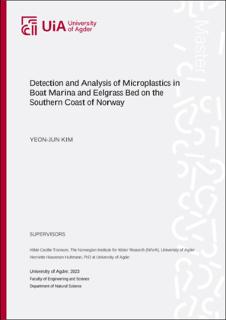| dc.description.abstract | Microplastics are widely distributed around the world and are emerging as one of the most serious environmental problems worldwide. This study aimed to investigate the presence and sources of microplastics by human activities in two different marine environments in the boat marina (Site 1) and the eelgrass bed (Site 3) on the southern coast of Norway. Boat activities in Norway are active due to the long coastline. Boat marinas can be a potential source of microplastic due to the narrow entrance of the marina, which can trap and precipitate microplastics in tidal eddies. Eelgrass, also known as Zostera marina, is an extensive seagrass species distributed along the entire coastline of Norway. Eelgrass beds play an important role in marine ecosystems by providing important habitats for marine life, but they have recently become vulnerable to pollution, including microplastics. This study evaluated microplastic accumulation in the sediments of the boat marina and the eelgrass bed by FTIR spectroscopy. The sediment samples were collected from two sites and different types of microplastic polymers were identified. A total of 35 microplastics were found, with 17 microplastics in Site 1 (168.3 MPs/kg dry sediment) and 18 microplastics in Site 3 (1182.6 MPs/kg dry sediment). In addition, the average size of microplastics found on the southern coast of Norway was 1.76 mm. The shapes of microplastics were in the order of fragment, film, fiber, and foam. The study found no clear relationship between local human activities and the distribution of microplastics, highlighting the need for sustained efforts to reduce their presence in both areas. Additionally, the study emphasizes the importance of further research on microplastics in boat marinas and eelgrass beds and the need for predictive technologies and environmental guidelines to manage microplastics in the oceans. Finally, I urge policymakers, stakeholders, and the general public to take action to reduce the production, use, and disposal of single-use plastics, and to promote more sustainable and circular models of production and consumption. | |
